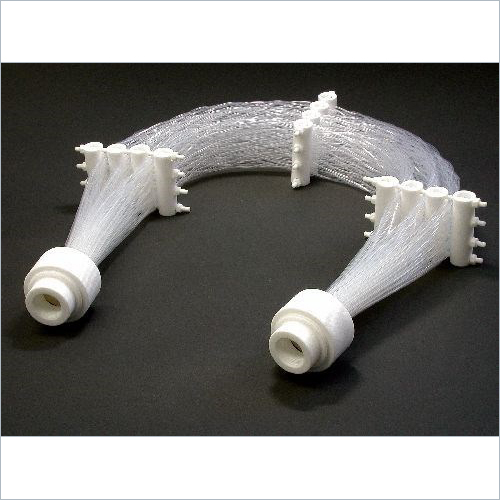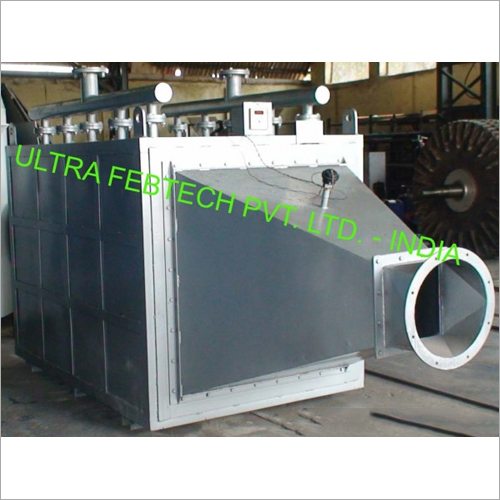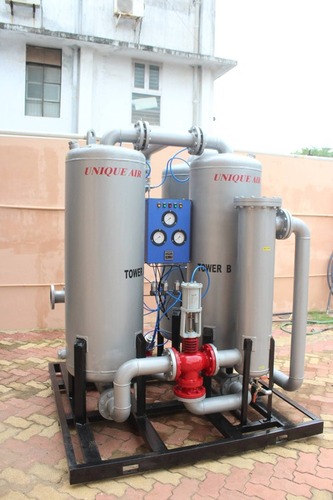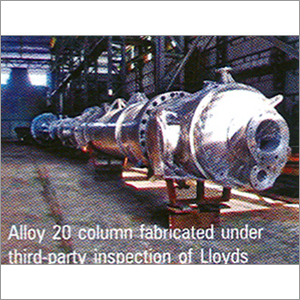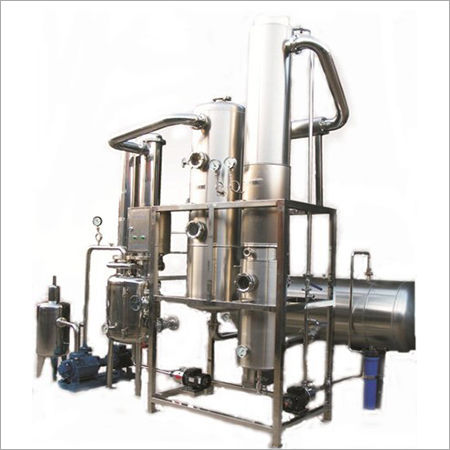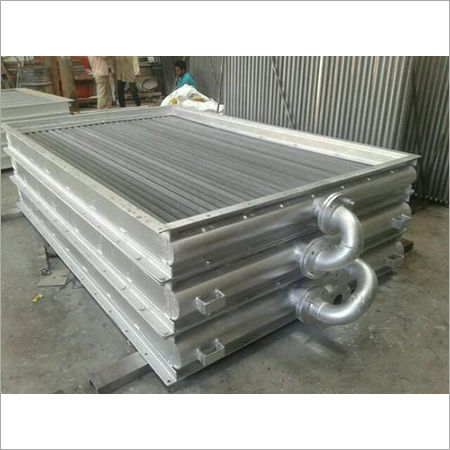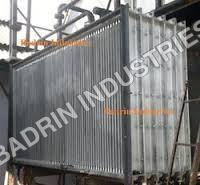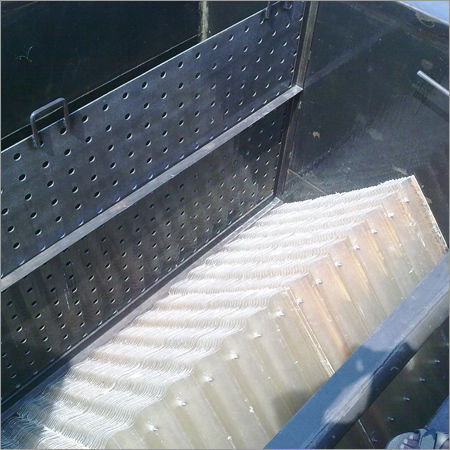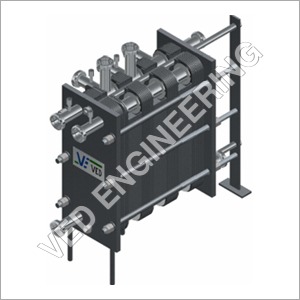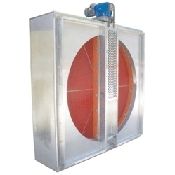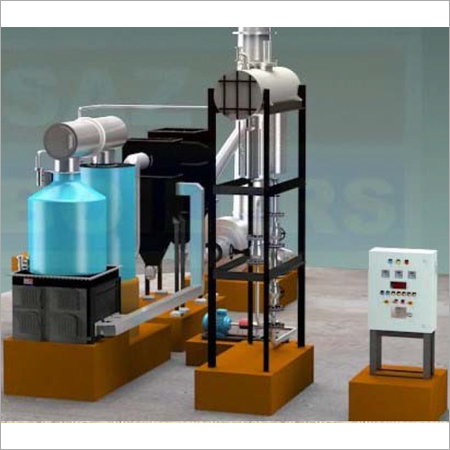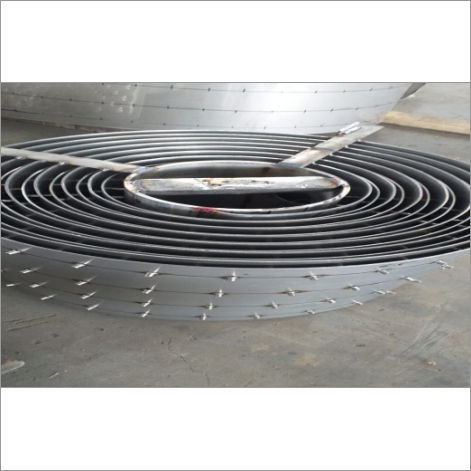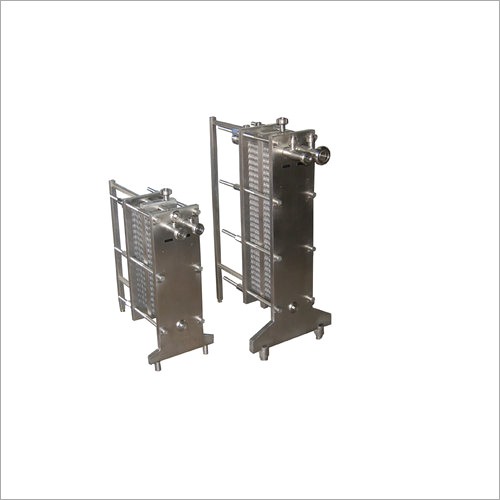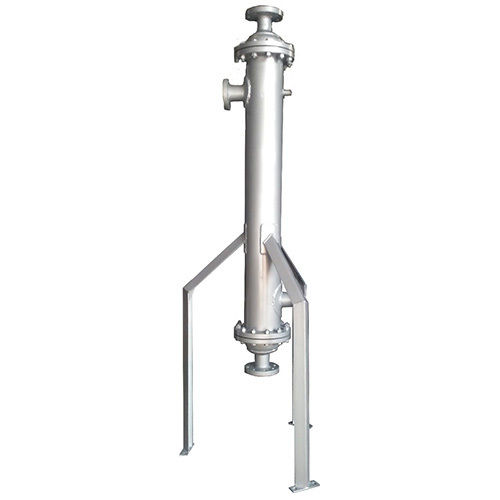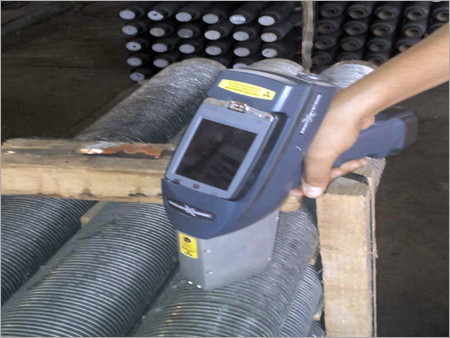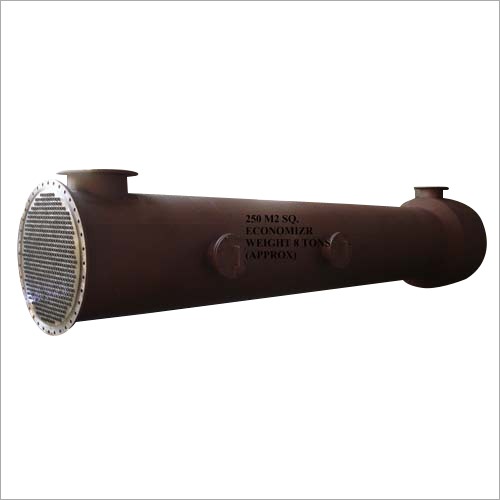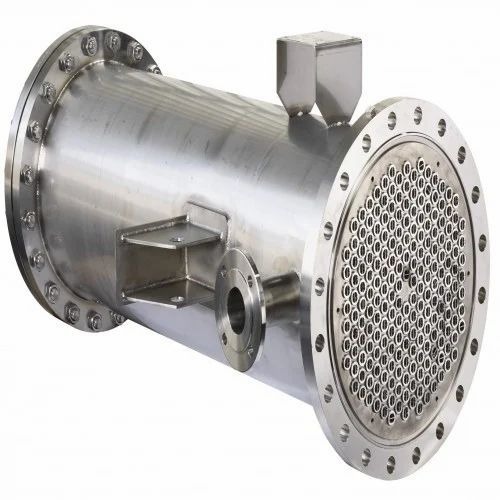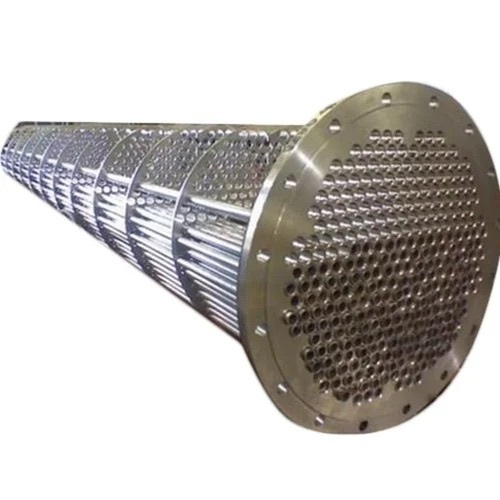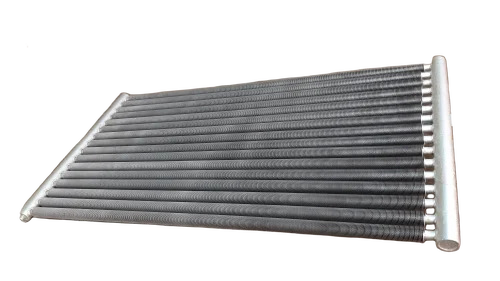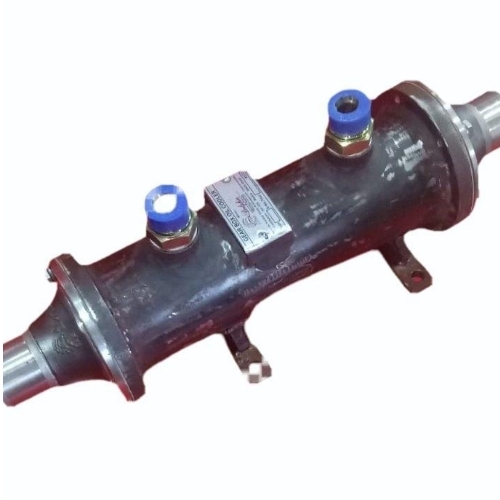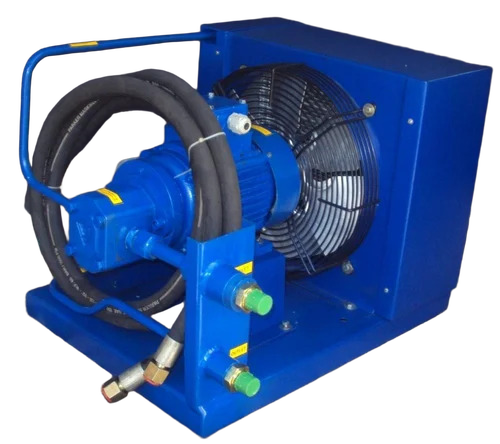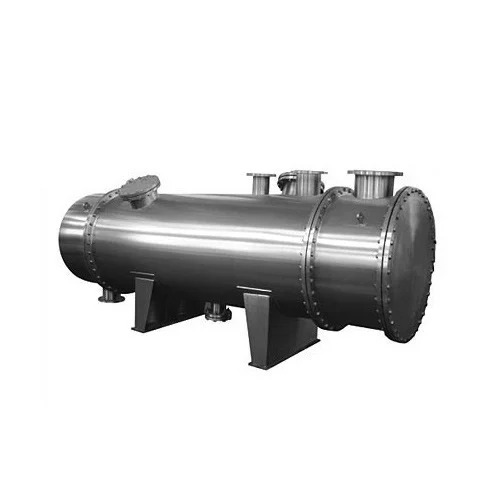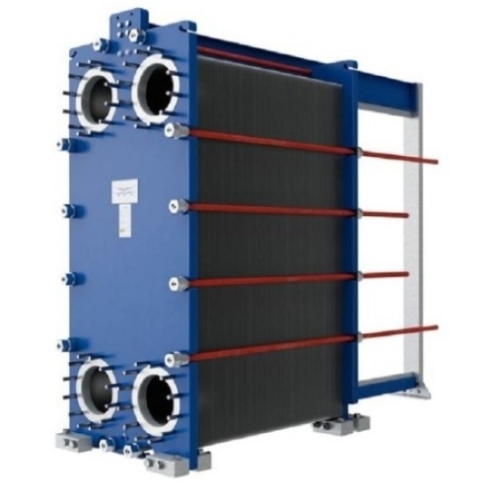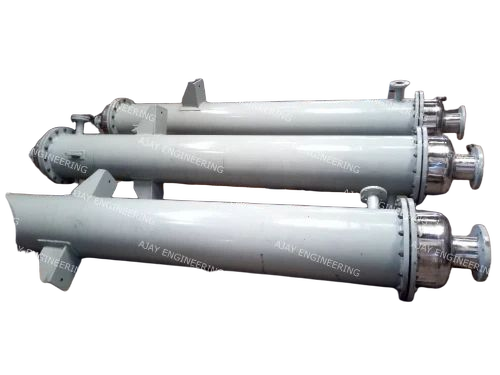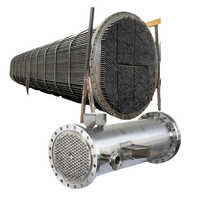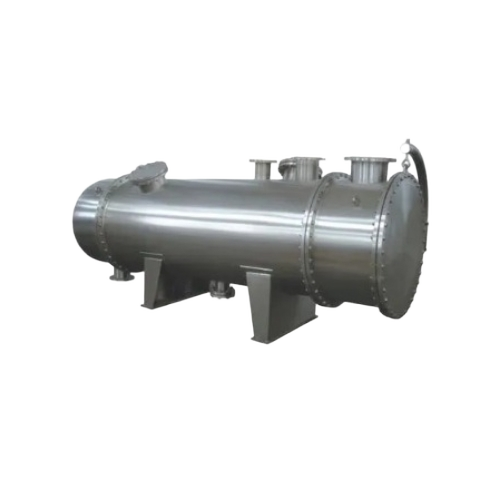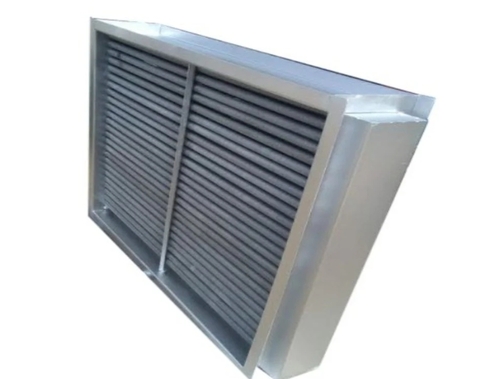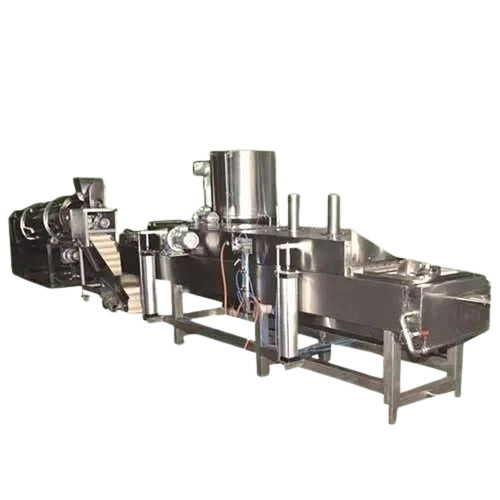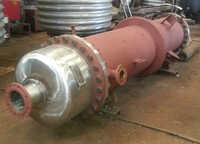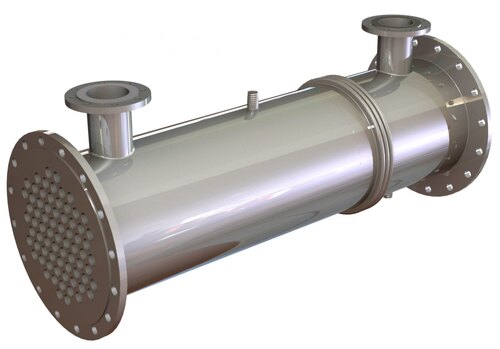Heat Exchangers
(5370 products)Heat Exchangers - Color: Black
6000 INR (Approx.)/Piece
MOQ10 Piece/Pieces
Product TypeHeat Exchangers
ColorBlack, Silver, Blue
TemperatureMedium-Temperature
SizeStandard
UsageIndustrial
ConditionNew
White Fluoropolymer Heat Exchanger
MOQ10 Unit/Units
ConditionNew
Usageindustrial
Structuretube Heat Exchanger
Product TypeFluoropolymer Heat Exchanger
ColorWhite
Hi-tech Applicator
Ahmedabad
 Super Bonanza
Super Bonanza Trusted Seller
Trusted Seller18 Years
Industrial Heat Exchanger - Stainless Steel, Automatic Operation at Up to 280 Volt | High Durability, Effective in Cooling and Heating Processes
Price: 200000 INR/Unit
MOQ1 Unit/Units
ColorSilver
ConditionNew
UsageIndustrial
Structuretube Heat Exchanger
SizeStandard
Product TypeHeat Exchangers
Ultra Febtech Private Ltd.
Ahmedabad
 Trusted Seller
Trusted Seller Super Premium
Super Premium Super Seller
Super Seller4 Years
Heatless Air Dryer - Color: White
Price: 5000 INR/Unit
MOQ1 Unit/Units
Max. Capacity10 Cubic Feet Per Minute (ft3/min)
TemperatureHigh-temperature
ColorWhite
ConditionNew
UsageIndustrial
Structuretube Heat Exchanger
Unique Air Products
Vadodara
 Trusted Seller
Trusted Seller Super Premium
Super Premium15 Years
Double Pipe Heat Exchanger - Copper Alloy, Compact Design, Efficient Heat Transfer, High Durability, Versatile Applications
Price Trend: 500000.00 - 1500000.00 INR/Set
MOQ1 , Set/Sets
Product DescriptionDouble Pipe Heat Exchanger
V Tech Engineering
Indore
 Trusted Seller
Trusted Seller Super Seller
Super Seller Premium Seller
Premium Seller16 Years
Heat Exchangers - High-Performance Aluminum Alloy , Compact Design for Efficient Thermal Transfer
Price: 200000.00 INR/Unit
MOQ1 Unit/Units
Diameter480 mm
Thickness4.5 mm
Max Pressure16 bar
Number of Pipe60
Max. Capacity50,000 kcal/h
ConditionNew
Dipesh Engineering Works
Mumbai
 Trusted Seller
Trusted Seller Super Premium
Super Premium23 Years
Shell And Tube Heat Exchanger - Usage: Industrial
MOQ1 Unit/Units
TemperatureHigh-temperature
UsageIndustrial
ConditionNew
Structuretube Heat Exchanger
Voltage280 Volt (v)
Luftsol Engineering Private Limited
Pune
 Trusted Seller
Trusted Seller Super Seller
Super Seller2 Years
Gray Scraped Surface Heat Exchanger
MOQ1 Unit/Units
ColorGray
UsageIndustrial
Product TypeScraped Surface Heat Exchanger
ConditionNew
Structuretube Heat Exchanger
Voltage220 Volt (v)
Sahyadri Engineering Corporation
Mumbai
 Trusted Seller
Trusted Seller Premium Seller
Premium Seller3 Years
Mechanical Vapour Recompression System - Liquid Flow Rate: 5 M3/H Cubic M/S
Price: 2000000 INR/Piece
MOQ1 Piece/Pieces
Width10-50 Meter (m)
Product TypeMechanical Vapour Recompression
ConditionNew
Structuretube Heat Exchanger
Liquid Flow Rate5 M3/H Cubic m/s
Working Presssure50 Kg/cm2
Ketav Consultant
Gandhinagar
 Trusted Seller
Trusted Seller Super Premium
Super Premium Super Seller
Super Seller Premium Seller
Premium Seller16 Years
Manual Shell Heat Exchanger
Price Trend: 45000000.00 - 50000000.00 INR/Unit
MOQ1 Unit/Units
TypeHeat Exchanger
MaterialSteel
ComputerizedNo
Automatic GradeManual
Control SystemFrequency Speed Control
Voltage440 Volt (v)
Sparktech Processes Llp
Mumbai
 Trusted Seller
Trusted Seller15 Years
Silver Thermic Fluid Heat Exchanger For Sago Industries
Price: 60000 INR/Piece
MOQ1 Piece/Pieces
TemperatureOther, Up to 350AdegC
Max Pressure12 bar
Max. Capacity100,000 Kcal/hr
Colorsilver
UsageIndustrial
ConditionNew
Thermal Energy Solutions
Chennai
 Trusted Seller
Trusted Seller Premium Seller
Premium Seller13 Years
Sugar Mill Heat Exchanger
Price Trend: 10000.00 - 100000.00 INR/Piece
MOQ5 Piece/Pieces
Diameter200mm aEUR" 1200mm (customized)
Max Pressure10 bar
Number of PipeUp to 150 tubes
TemperatureOther, Up to 150AdegC
Thickness5mmaEUR"12mm (shell and tubes, as per design)
Max. CapacityUp to 80,000 LPH (as per requirement)
Badrin Industries
Chennai
 Trusted Seller
Trusted Seller Super Seller
Super Seller Premium Seller
Premium Seller22 Years
Heat Exchanger - Color: Any
Price: 100000 INR/Unit
MOQ1 Unit/Units
ColorAny
UsageIndustrial
Product TypeHeat Exchanger
ConditionNew
Sunrise Process Equipments Private Limited
Mumbai
 Trusted Seller
Trusted Seller Super Seller
Super Seller22 Years
Grey Plate Pack Distribution Unit (Heat Exchanger)
Price: 400000.00 INR/Unit
MOQ1 Unit/Units
ColorGrey
ConditionNew
UsageIndustrial Use
Product TypePlate Pack Distribution Unit (Heat Exchanger)
Weight20.00 Kilograms (kg)
K-pack Systems Private Limited
Bengaluru
 Trusted Seller
Trusted Seller Super Seller
Super Seller Premium Seller
Premium Seller15 Years
Sliver Heat Exchanger
Price: 150000 INR/Unit
MOQ1 Unit/Units
Usageindustrial
ColorSliver
Product TypeHeat Exchanger
ConditionNew
StructureOther, Heat Exchanger
Pratham Engineering
Mira Bhayandar
 Trusted Seller
Trusted Seller14 Years
Multi Section Heat Exchangers - 10-36m3/h Liquid Flow Rate, 220-440 Volt Power Supply, New Design for Biopharm Cooling/Heating
Price Trend: 25000.00 - 35000.00 INR/Unit
MOQ1 Piece/Pieces
Usagecooling/heating of pure water in the biopharm industry and cooling/heating
ConditionNew
StructureOther, Multi Section Heat Exchangers
Liquid Flow Rate10-36m3/h
Voltage220-440 Volt (v)
Power50-60 hz
Ved Engineering
Noida
 Trusted Seller
Trusted Seller Premium Seller
Premium Seller12 Years
BryXchange - High Heat Capacity Fluted Rotor | Efficiently Recovers Up to 75% Energy From High Temperature Exhaust Air
Product DescriptionBry-Airs BryXchange is an air to air rotary heat exchanger which recovers energy from high temperature exhaust air. Considerable high temperature air is generated in kilns, ovens, furnaces etc which generally goes waste.\015\012\015\012Through BryExchange this sensible waste energy can be recovered
Bry-air (asia) Pvt. Ltd.
Gurugram
 Trusted Seller
Trusted Seller Super Seller
Super Seller16 Years
Wood Fired Thermic Fluid Heaters Usage: Industrial
Price: 2500000 INR/Unit
MOQ1 , Unit/Units
ConditionNew
UsageIndustrial
Product TypeWood Fired Thermic Fluid Heaters
Voltage380 Volt (v)
Saz Boilers
Pune
 Trusted Seller
Trusted Seller Super Seller
Super Seller Premium Seller
Premium Seller7 Years
Vertical Thermic Fluid Heater - Capacity: 25K-1500K Kcal/Hr | Features: Automatic Operation, Smokeless Combustion, High Efficiency, Noiseless
Product DescriptionIn recent times, thermic fluid heaters have found wide applications for indirect process heating. Employing petroleum - based fluids as the heat transfer medium, these heaters provide constantly maintainable temperatures for the user equipments. The combustion system comprises of a fixed grate with
Therm Tech Industries
Ahmedabad
 Trusted Seller
Trusted Seller Super Seller
Super Seller Premium Seller
Premium Seller5 Years
Surface Steam Condenser - Alloyed Material, Large Cylindrical Design, High Rigidity and Strength | New Condition, Safe Operation at Extreme Temperatures and Pressures
Price: 2500000 INR/Unit
MOQ1 Unit/Units
SizeDifferent Available
Product TypeSurface Steam Condenser
UsageIndustrial
ThicknessDifferent Available Millimeter (mm)
ConditionNew
Karunanand Hydro-pneumatic Controls Pvt. Ltd.
Ambernath
 Trusted Seller
Trusted Seller Super Seller
Super Seller11 Years
Spiral Wound Heat Exchanger - Medium-Temperature, Grey | New Industrial Usage
UsageIndustrial
Product TypeSpiral Wound Heat Exchanger
TemperatureMedium-Temperature
ColorGrey
ConditionNew
Yantrik Engineers
Pune
 Trusted Seller
Trusted Seller Premium Seller
Premium Seller7 Years
Industrial Plate Heat Exchanger Voltage: 220-240 Volt (V)
Price: 75000 INR/Unit
MOQ1 Unit/Units
UsageIndustrial
Product TypePlate Heat Exchanger
SizeCustomized
ConditionNew
Voltage220-240 Volt (v)
Shreya Engineering Works
Anand
 Trusted Seller
Trusted Seller Premium Seller
Premium Seller4 Years
Heavy Duty Heat Exchanger - Size: Different Sizes Available
Price: 135000.00 INR/Unit
MOQ1 Unit/Units
UsageIndustrial
ConditionNew
SizeDifferent Sizes Available
Vishwakarma Engineering
Vadodara
 Trusted Seller
Trusted Seller Super Seller
Super Seller3 Years
Heat Exchanger
Price: 15000 INR/Piece
MOQ1 Piece/Pieces
Number of Pipe52 tubes
Max Pressure15 bar
TemperatureOther, -10AdegC to 150AdegC
Diameter350 mm
Thickness6 mm
Max. Capacity120,000 kcal/hr
Swastik Enterprise
Ahmedabad
 Trusted Seller
Trusted Seller Premium Seller
Premium Seller9 Years
Air Cooled Heat Exchanger - Color: Black
Price: 1000000.0 INR/Unit
MOQ1 Kilograms/Kilograms
ColorBlack
TemperatureHigh-temperature
UsageIndustrial
ConditionNew
SizeStandard
Voltage220 Volt (v)
Akshar Precision Tubes Pvt. Ltd.
Vadodara
 Trusted Seller
Trusted Seller Premium Seller
Premium Seller13 Years
Boiler Economizer Heat Exchanger
Price: 17000 INR/Unit
MOQ100 Unit/Units
Supply Ability1000 Per Month
Delivery Time10 Days
Mechno Tech
Dewas
 Trusted Seller
Trusted Seller Super Seller
Super Seller6 Years
Grey Heat Exchangers
Price: 1000000.0 INR/Unit
MOQ1 Unit/Units
ColorGrey
ConditionNew
UsageIndustrial
Product TypeHeat Exchangers
Voltage220 Volt (v)
Power228 Watt (w)
Pragya Precision Equipment Private Limited
Indore
 Trusted Seller
Trusted Seller Super Seller
Super Seller3 Years
Heat Exchanger System - Color: Grey
Price: 60000.0 INR/Piece
MOQ5 Piece/Pieces
TemperatureMedium-Temperature
ColorHalf White
ConditionNew
UsageIndustrial And Commercial
TypeSolar
StructurePlate Heat Exchanger
Sunzone Solar System India Private Limited
Bengaluru
 Trusted Seller
Trusted Seller Premium Seller
Premium Seller6 Years
Shell and Tube Heat Exchanger - Stainless Steel, Industrial Size Options, Silver Color, High-Temperature Efficiency, Multi-Pass Design
Price: 50000 INR/Unit
MOQ1 Unit/Units
Product TypeTube Heat Exchanger
ColorSilver
SizeDifferent Available
UsageIndustrial
TemperatureHigh-temperature Celsius (oC)
ConditionNew
Prime Advance Polishing System Pvt. Ltd.
Vadodara
 Trusted Seller
Trusted Seller Super Seller
Super Seller16 Years
Latest From Heat Exchangers
Popular Heat Exchangers
What Is Heat Exchangers
Introduction
A heat exchanger, in its simplest form, is any device that moves heat from one medium to another; for instance, a Hydraulic Oil Cooler transfers the heat of heated oil to cool water or air. Pool water can also be heated via a heat exchanger that draws hot water from a boiler or solar heated water circuit. Through the materials of the heat exchanger, heat is exchanged between the two media. When cooling liquid, a shell and tube heat exchanger directs the fluid through and over the tubes, whereas an air cooled heat exchanger directs the air through a core of fins.
Types of Heat Exchangers
1. Micro channel heat Exchanger
They are multi-pass parallel-flow heat exchangers, and its components are input and exit manifolds, tubes with multiple ports, hydraulic channels thinner than 1 mm in diameter, and fins. When joining these components, a controlled environment brazing procedure is typically used.
2. Phase Change heat Exchanger
Due to the negligible size change between the solid and liquid states, this phase transition typically occurs. This phase transition acts as a buffer, allowing for additional heat to be acquired while maintaining a steady temperature. When it comes to energy storage, phase change materials really shine.
3. Adiabatic heat Exchanger
This particular heat exchanger finds widespread application in manufacturing. One side of the heat exchanger stores heat in a fluid while the other side transfers it elsewhere.
4. Finned heat exchanger
To better conduct heat in liquids with low thermal conductivity, like air, finned tube heat exchangers are built to refer to the highest heat transfer surface area with the exchanged heat. It's made up of a network of tubes with fins attached to maximize the surface area in contact with the external fluid and the surface area in contact with the fluid inside the tube, allowing for more efficient heat transfer.
5. Pillow Plate heat Exchanger
Products in manufacturing facilities can benefit from both their cooling and heating capabilities with these. As they inflate, the wavy "pillow-shaped" surface of these heat exchangers is formed. Typical applications for these include reboilers, water chillers, solids dryers, and so on. The cooling of milk in huge stainless steel bulk tanks is a popular application of this type of heat exchanger.
6. Plate Heat Exchanger
These heat exchangers use metal plates to transfer heat, as their name implies. The fluids in motion can move freely because of the channels formed by the metal plates.
Plate Heat Exchangers are constructed from many individual flat plates that are linked together to create a network of channels via which heat and cold can be transferred. This is because the heat penetrates the surface, creating a barrier between the hot and cold media.
For this reason, the energy required to heat or cool liquids and gases is quite small. Compared to shell and tube, they can sometimes be cheaper and take up less space. The water heating and air conditioning industries rely heavily on these.
7. Direct Heat Exchanger
In the absence of an insulating wall, direct heat exchangers facilitate the transfer of heat between two streams of hot and cold currents. The heat transfer process occurs concurrently when the hot and cold liquids are mixed together, eliminating the need for a heat exchanger. There are a few types of cooling towers and jet condensers.
8. Indirect Heat Exchanger
Because of the impermeability of the barrier between the two common fluids, the temperature difference between the two common fluids can be measured indirectly using an indirect heat exchanger. Tubes, plates, and other heat-insulating materials maintain the fluids being exchanged at different temperatures.
9. Double Pipe heat Exchanger
The inner pipe works as a conductive barrier, allowing one liquid to flow through it while another flows between it and the outer pipe. It finds widespread application in manufacturing, cooling technology, refrigeration, and other areas due to its high efficiency and low capital cost.
10. Tube in tube heat exchanger
The heating and cooling needs of sludge including fibers and particles are met by a tube-in-tube heat exchanger.
With the introduction of tube in tube heat exchangers, a tube is introduced inside of a tube. Within the tube, the product medium floats countercurrent to the service medium as the tube operates. The product tube may be plain or folded.
This innovative layout saves bulk, boosts performance, and stops thermal exhaustion.
11. Shell and Tube heat exchanger
These heat exchangers are the most popular and adaptable ones used today. Within a cylindrical housing, this heat exchanger's many tubes come into direct thermal contact with the two working fluids, exchanging heat in the process.
This configuration allows one fluid to move inside the tubes while another moves outside the shell. A shell and tube heat exchanger is a small, low-maintenance, and high-performing heat exchanger design. Preheating, oil cooling, and steam production are all possible with this heat exchanger.
What Is the Principle of Heat Exchanger.
Heat exchangers are predicated on the principles outlined in the laws of thermodynamics.
- 1. In a state of thermal equilibrium, all thermodynamic systems have the same temperature, as required by the Thermodynamics. If two systems are in thermodynamic equilibrium with a third, then the temperatures of all three must be equal.
- 2. It is impossible to create or destroy energy, according to the First Law of Thermodynamics, yet energy can be transferred from one medium to another in the form of heat.
- 3. A closed thermodynamic system has a natural, invariable tendency to rise in entropy over time, as described by the Second Law of Thermodynamics, which establishes entropy (S) as an extra attribute of thermodynamic systems.
What Are the Advantages of Heat Exchanger.
1. Minimal Operating Cost
Heat exchangers do not need to be maintained as frequently as air conditioners do since they do not employ complex external equipment and because they are designed to eliminate the majority of pollution.
They are also extremely durable, with the ability to outlive the majority of air conditioning units by many orders of magnitude before requiring maintenance, repair, or replacement.
2. Lower Environmental Impact
Heat exchangers have to be kept in a constant state of operation in order for them to be successful in preventing high-powered control panels from overheating.
The fact that modern heat exchangers do not need supplementary apparatus to function well, such as air conditioning or air compression units, is one of the most significant advantages offered by these devices.
As a result, in comparison to other, more conventional techniques of temperature control, they consume an enormous amount less energy and generate almost no pollution.
3. Smaller Spatial Footprint
It would appear that more powerful also means smaller as a result of the progression of modern technology.
This includes smaller personal devices, smaller and more adaptable manufacturing equipment, and a number of other examples. As the amount of space available in electrical cabinets decreases, the potential for heat pockets and the subsequent damage to electrical components increases.
As a result, there is an increased demand for cooling solutions that are both more compact and more effective, such as heat exchangers.
4. High Heat Transfer Coefficient
The heat transfer coefficient of the air-cooled heat exchanger is high, and it is commonly estimated to be three to five times higher than the heat transfer coefficient of the shell-and-tube heat exchanger.
The heat exchange area of an air-cooled heat exchanger is much less than half of the heat exchanges area of a shell-and-tube heat exchanger while performing the identical heat exchange duty;
5. Large Temperature Difference Correction Coefficient
The flow patterns of the two fluids in a shell-and-tube heat exchanger are typically described as being cross-flowing, as they take place in the shell and tube sections, respectively.
The logarithmic mean temperature difference needs to be adjusted since additional investigation reveals that the flow on the shell side is a mixed flow and the flow along the tube length is a multi-strand flow. In most cases, the factor is not very significant.
Air-cooled heat exchangers typically have either a countercurrent or concurrent fluid flow pattern.
FAQs: Heat Exchangers
Q. What are heat exchangers used for?
Ans: There are a wide variety of engineering uses for heat exchangers, including cooling, heating, air conditioning, power generation, waste heat recovery, vehicle radiators, and chemical and food processing.
Q. What is heat exchanger and example?
Ans: Shell & Tube is the most common heat exchanger example that uses for parallel arrangements of tubes.
Q. What liquid is used in heat exchangers?
Ans: Heat transfer fluids include liquids like synthetic oil, molten salt, and water. Due to its large thermal capacity and low viscosity, water makes for an excellent heat transfer fluid.
Q. Which type of heat exchanger is mostly used?
Ans: Shell and Tube are the main heat exchanger that is mostly used in food industry.
Manufacturers & Suppliers of Heat Exchangers
Company Name | Member Since |
|---|---|
Dipesh Engineering Works Mumbai, India | 23 Years |
Badrin Industries Chennai, India | 22 Years |
Sunrise Process Equipments Private Limited Mumbai, India | 22 Years |
Hi-Tech Applicator Ahmedabad, India | 18 Years |
V Tech Engineering Indore, India | 16 Years |
Ketav Consultant Gandhinagar, India | 16 Years |
Bry-Air (Asia) Pvt. Ltd. Gurugram, India | 16 Years |
Prime Advance Polishing System Pvt. Ltd. Vadodara, India | 16 Years |
Unique Air Products Vadodara, India | 15 Years |
Sparktech Processes Llp Mumbai, India | 15 Years |
Popular Products




